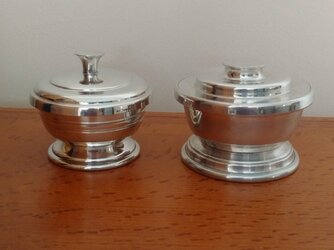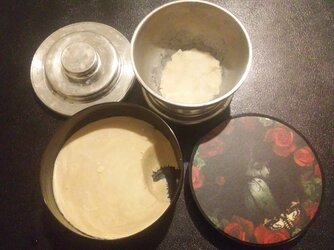AimlessWanderer
Remember to forget me!
After spending a fair bit of time and money accumulating exploring different brushes last year, I soon discovered that they all needed different approaches to yield the best results. As most lather tutorials don't seem to factor in the individual brushes characteristics, I decided to share a brief summary of not just my methods, but also which brushes they work with, and which they don't.
Method 1: Conventional Face Lathering
I start with a damp brush. Most of the water having been shaken out before loading. I load soap off the puck, or cream from a bowl, and paint it on to the face while still of quite a pasty consistency. I then gradually add water, working it in as I go. Whether I pain or swirl depends on the brush, and stubble length. What I personally aim for, is as wet as possible, with minimal air content, and I keep adding water until it's almost starting to run
Works great with moderate to high backbone brushes, with good elasticity and springback.
Works poorly with lower backbone brushes, as the thick lather clogs the core, matts up the hairs, and inhibits proper bristle action. Instant lather mop.
Method 2: Conventional Bowl Lathering
Pretty much the same start point (loading with a damp brush), but the lather is gradually hydrated in a bowl, rather than on the face. Again, water is added gradually, to creep up on the correct hydration level, before taking the lather to the face.
Works great on my mixed hair brushes. The more sluggish boar hair not incorporating too much air
Works OK with some of my lower backbone brushes, so long as I can keep the core of the knot free of dense lather, so it doesn't gum up.
Works abysmally (for me) with stiffer badger brushes and synthetics. Far too much air incorporated, killing sickness, and turning the lather to a near meringue consistency.
Method 3: Face Applied Soap/Cream
Whether this is from rubbing a shave stick or hard puck on a wet face, or smearing cream directly on the face, trying to lather this way with too scrubby a brush is a recipe for pain (brush burn). Two very different types of brush work for me here. Synthetics work very well if I paint and add water gradually. On the other hand, very soft floppy badgers work well for me if I get stuck in with quite a wet brush. If the root of the knot is full of water, there's no room for rich lather to accumulate. That said, it can be messy, as the water can flood from the base of the knot, so it's important to keep wetting the knot well, to keep freeing up the bristles.
Works great with synthetics if painting
Works great with wet supersoft brushes
You can scrub your face raw (friction burns) with stiff badger and boar brushes.
Method 4: Layering
This works well with nearly all brushes, though lower backbone brushes need a slight tweak to the method. This method alternates adding soap and water. I start with a damp brush, but don't load enough soap (intentionally) for a full shave. I paint that on, then dip the brush on water, then paint that on. Load a bit more soap, paint that on, then paint in more water.
This method floods the beard with soapy water, as an integral prep, and as you gradually add more soap, that "soup" thickens up to a wonderfully super slick lather. This can choke up floppy brushes though, and I find myself having to dunk the whole knot to free up the gummed up core of the knot. Moderately low backbone brushes will keep free enough to work effectively, but the most spineless brushes will not. By the time you've freed up the knot, you've turned the lather to a complete washout.
Works great with boar, badger, and synthetic, from high down to moderately low backbone brushes. It's also good for working with brushes that can hog lather, as it keeps most of the action toward the tips.
Works poorly with the lowest backbone brushes... but I have a special method for those next.
Method 5: Liquid load
This is the one that will get some folks here having kittens!
This is awesome for keeping the innermost fibres of the floppiest brushes moving freely, and working effectively. Instead of adding water to soap, this revolves around adding soap to water. Dunk/soak the brush, and agitate under water to chase out any air, then lift the brush out and wait for the excess to run off. When it stops dribbling, that it the maximum amount of water that brush can hold. And we're going to use all of it!
Wipe the knot on the lip of your lather bowl to collect all that water inside, then using the now damp brush, load off the soap as normal. Go back to the bowl, and "rinse" the soap off into the water collected. As you keep swirling the brush, it will 'drink' it back up again. Wipe the brush on the lip of the bowl again, and let that soapy liquid run back into the bowl once more.
If that liquid is milk thickness or thinner, load again off the soap, and again, 'rinse' it in the lather bowl. The liquid ideally wants to be somewhere between milk and single cream the next time you wipe the brush on the rim to release the liquid. No more soap should be needed now, just "bowl lather" with minimal pressure, and let the brush drink it back up again.
Now face lather.
This might be a little messy to start with, but this will give you the very best bristle action from your floppiest brushes. This can turn lifeless mops into truly wonderful lather machines. Paint and swirl to your heart's content, but be sure you're leaning over the sink when you do. If you've got any ineffective floppy brushes in your array, do give this method a try. Obviously, it'll need a little experimentation to identify the right fluid consistency for your brush. Don't expect meringue face lathers from this method, just super slick and abundantly hydrated lathers.
Possible variations include squeezing cream into the lather bowl, before you first collect a brushful of water. You might need to add a little more cream later, as it breaks down into the liquid. Better to start with not enough than too much though.

For tub soaps, I serve up a sample sized spoonful into one of these pewter soap dishes, and mould it into the bottom.

That gives me another variation, as I can collect that initial brushful of water in this, and load up the soapy water in one hit. Again, I may need to wipe the brush to release the liquid then load again for best results.
Works best with the floppiest lower backbone brushes. (My Kent BLK2 grey badger absolutely LOVES this method)
Works poorly with stiffer backbone brushes
I wanted to keep this opening post as concise as possible (even though I probably failed miserably), to just give a general overview of what methods I use, and most importantly, when.
Not everyone will agree with my rationale. We all have different lather preferences, different water chemistry, etc. But hopefully this might help someone matchup the best methods for their brushes, and get their shaves off to a better start. I do expect comments and criticisms, so fire away, but please keep it kind and civil. I don't expect us to all be in agreement throughout.
Cheers
Method 1: Conventional Face Lathering
I start with a damp brush. Most of the water having been shaken out before loading. I load soap off the puck, or cream from a bowl, and paint it on to the face while still of quite a pasty consistency. I then gradually add water, working it in as I go. Whether I pain or swirl depends on the brush, and stubble length. What I personally aim for, is as wet as possible, with minimal air content, and I keep adding water until it's almost starting to run
Works great with moderate to high backbone brushes, with good elasticity and springback.
Works poorly with lower backbone brushes, as the thick lather clogs the core, matts up the hairs, and inhibits proper bristle action. Instant lather mop.
Method 2: Conventional Bowl Lathering
Pretty much the same start point (loading with a damp brush), but the lather is gradually hydrated in a bowl, rather than on the face. Again, water is added gradually, to creep up on the correct hydration level, before taking the lather to the face.
Works great on my mixed hair brushes. The more sluggish boar hair not incorporating too much air
Works OK with some of my lower backbone brushes, so long as I can keep the core of the knot free of dense lather, so it doesn't gum up.
Works abysmally (for me) with stiffer badger brushes and synthetics. Far too much air incorporated, killing sickness, and turning the lather to a near meringue consistency.
Method 3: Face Applied Soap/Cream
Whether this is from rubbing a shave stick or hard puck on a wet face, or smearing cream directly on the face, trying to lather this way with too scrubby a brush is a recipe for pain (brush burn). Two very different types of brush work for me here. Synthetics work very well if I paint and add water gradually. On the other hand, very soft floppy badgers work well for me if I get stuck in with quite a wet brush. If the root of the knot is full of water, there's no room for rich lather to accumulate. That said, it can be messy, as the water can flood from the base of the knot, so it's important to keep wetting the knot well, to keep freeing up the bristles.
Works great with synthetics if painting
Works great with wet supersoft brushes
You can scrub your face raw (friction burns) with stiff badger and boar brushes.
Method 4: Layering
This works well with nearly all brushes, though lower backbone brushes need a slight tweak to the method. This method alternates adding soap and water. I start with a damp brush, but don't load enough soap (intentionally) for a full shave. I paint that on, then dip the brush on water, then paint that on. Load a bit more soap, paint that on, then paint in more water.
This method floods the beard with soapy water, as an integral prep, and as you gradually add more soap, that "soup" thickens up to a wonderfully super slick lather. This can choke up floppy brushes though, and I find myself having to dunk the whole knot to free up the gummed up core of the knot. Moderately low backbone brushes will keep free enough to work effectively, but the most spineless brushes will not. By the time you've freed up the knot, you've turned the lather to a complete washout.
Works great with boar, badger, and synthetic, from high down to moderately low backbone brushes. It's also good for working with brushes that can hog lather, as it keeps most of the action toward the tips.
Works poorly with the lowest backbone brushes... but I have a special method for those next.
Method 5: Liquid load
This is the one that will get some folks here having kittens!
This is awesome for keeping the innermost fibres of the floppiest brushes moving freely, and working effectively. Instead of adding water to soap, this revolves around adding soap to water. Dunk/soak the brush, and agitate under water to chase out any air, then lift the brush out and wait for the excess to run off. When it stops dribbling, that it the maximum amount of water that brush can hold. And we're going to use all of it!
Wipe the knot on the lip of your lather bowl to collect all that water inside, then using the now damp brush, load off the soap as normal. Go back to the bowl, and "rinse" the soap off into the water collected. As you keep swirling the brush, it will 'drink' it back up again. Wipe the brush on the lip of the bowl again, and let that soapy liquid run back into the bowl once more.
If that liquid is milk thickness or thinner, load again off the soap, and again, 'rinse' it in the lather bowl. The liquid ideally wants to be somewhere between milk and single cream the next time you wipe the brush on the rim to release the liquid. No more soap should be needed now, just "bowl lather" with minimal pressure, and let the brush drink it back up again.
Now face lather.
This might be a little messy to start with, but this will give you the very best bristle action from your floppiest brushes. This can turn lifeless mops into truly wonderful lather machines. Paint and swirl to your heart's content, but be sure you're leaning over the sink when you do. If you've got any ineffective floppy brushes in your array, do give this method a try. Obviously, it'll need a little experimentation to identify the right fluid consistency for your brush. Don't expect meringue face lathers from this method, just super slick and abundantly hydrated lathers.
Possible variations include squeezing cream into the lather bowl, before you first collect a brushful of water. You might need to add a little more cream later, as it breaks down into the liquid. Better to start with not enough than too much though.

For tub soaps, I serve up a sample sized spoonful into one of these pewter soap dishes, and mould it into the bottom.

That gives me another variation, as I can collect that initial brushful of water in this, and load up the soapy water in one hit. Again, I may need to wipe the brush to release the liquid then load again for best results.
Works best with the floppiest lower backbone brushes. (My Kent BLK2 grey badger absolutely LOVES this method)
Works poorly with stiffer backbone brushes
I wanted to keep this opening post as concise as possible (even though I probably failed miserably), to just give a general overview of what methods I use, and most importantly, when.
Not everyone will agree with my rationale. We all have different lather preferences, different water chemistry, etc. But hopefully this might help someone matchup the best methods for their brushes, and get their shaves off to a better start. I do expect comments and criticisms, so fire away, but please keep it kind and civil. I don't expect us to all be in agreement throughout.
Cheers







